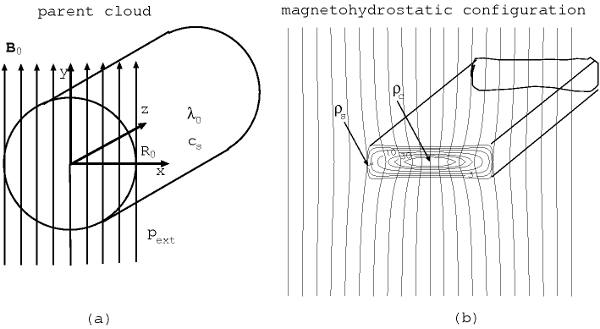| EPoS Contribution |
|
Magnetohydrostatic Equilibrium Structure and Mass of Filamentary Isothermal Cloud Threaded by Lateral Magnetic Field
Kohji Tomisaka NAOJ, Tokyo, JP | |
| Herschel observation has recently revealed that interstellar molecular clouds consist of many filaments. Polarization observations in optical and infrared wavelengths indicate that the magnetic field often runs perpendicular to the filament. In this paper, the magnetohydrostatic configuration of isothermal gas is studied, in which the thermal pressure and the Lorentz force are balanced against the self-gravity and the magnetic field is globally perpendicular to the axis of the filament. The model is controlled by three parameters: center-to-surface density ratio (ρc/ρs), plasma beta of surrounding interstellar gas (β0) and the radius of the hypothetical parent cloud normalized by the scale-height (R'0), although there remains a freedom how the mass is distributed against the magnetic flux (mass loading). In the case that R'0 is small enough, the magnetic field plays a role in confining the gas. However, the magnetic field generally has an effect in supporting the cloud. There is a maximum line-mass (mass per unit length) above which the cloud is not supported against the gravity. Compared with the maximum line-mass of non-magnetized cloud (2cs2/G, where cs and G represent respectively the isothermal sound speed and the gravitational constant), that of the magnetized filament is larger than the non-magnetized one. The maximum line-mass is numerically obtained as λmax = 0.24 Φcl/G1/2 + 1.66 cs2/G, where Φcl represents one half of the magnetic flux threading the filament per unit length. The maximum mass of the filamentary cloud is shown to be significantly affected by the magnetic field when the magnetic flux per unit length exceeds Φcl > 3 pc μ G (cs/190 m s-1)2. | |
 | |
| Caption: Model of magnetohydrostatic filamentary cloud. Mass distribution against the magnetic flux is given as a uniform B-field is threading a cylinder with a uniform density (left). Equilibrium solution is as shown in the right panel. | |
|
Key publication
Suggested Sessions: Filaments | |

